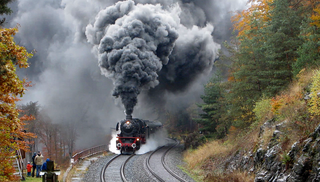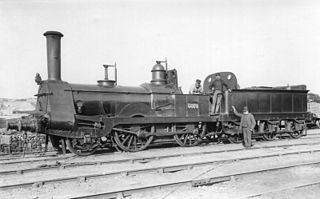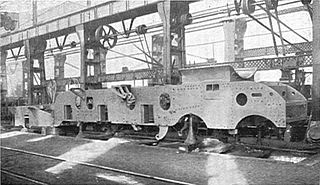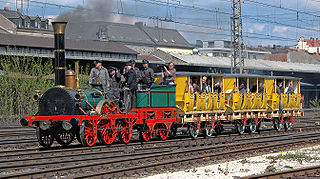The Manchester and Birmingham Railway was built between Manchester and Crewe and opened in stages from 1840. Between Crewe and Birmingham, trains were worked by the Grand Junction Railway. The M&BR was merged into the London and North Western Railway in 1846.

The North Staffordshire Railway (NSR) was a British railway company formed in 1845 to promote a number of lines in the Staffordshire Potteries and surrounding areas in Staffordshire, Cheshire, Derbyshire and Shropshire.

Under the Whyte notation for the classification of steam locomotives, 0-8-0 represents the wheel arrangement of no leading wheels, eight powered and coupled driving wheels on four axles and no trailing wheels. Locomotives of this type are also referred to as eight coupled.
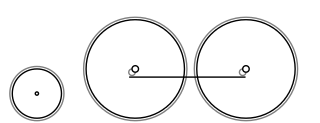
Under the Whyte notation for the classification of steam locomotives, 2-4-0 represents the wheel arrangement of two leading wheels on one axle, four powered and coupled driving wheels on two axles and no trailing wheels.
Locomotives of the London and North Western Railway. The London and North Western Railway (LNWR) Locomotive Department was headquartered at Crewe from 1862. The Crewe Works had been built in 1840–43 by the Grand Junction Railway.

The Liverpool and Manchester Railway (LMR) 57 Lion is an early 0-4-2 steam locomotive, which had a top speed of 45 mph (72 km/h) and could pull up to 200 tons. One of a pair designed for hauling freight, built by Todd, Kitson & Laird of Leeds in 1838. It was also used in the 1953 film The Titfield Thunderbolt.
Edge Hill railway works was built by the Liverpool and Manchester Railway around 1830 at Edge Hill, Liverpool. A second was built in 1839 by the Grand Junction Railway adjacent to it.

Jones, Turner and Evans was a locomotive manufacturer in Newton-le-Willows, England from 1837, known as Jones and Potts between 1844 and 1852.

The locomotives of the Dundalk, Newry and Greenore Railway were all 0-6-0ST, with inside cylinders, to the designs of LNWR Chief Mechanical Engineer, John Ramsbottom, the first three locomotives being built by the LNWR Crewe Works, England, in 1873. Later, to work the extension of the line to Newry, two similar locos were built at Crewe in 1876. The sixth and final locomotive was added in 1898. The locomotives were consecutively numbered, in order of building, from 1 to 6 and also carried names. Locomotive No.5 Carlingford was withdrawn in 1928 and scrapped.

The Crewe Works Railway was a narrow gauge internal tramway system serving Crewe Works, the main locomotive construction works of the London and North Western Railway (LNWR) and later the London Midland and Scottish Railway (LMS). The system was first introduced by John Ramsbottom the LNWR Locomotive Superintendent from 1857 and it was a pioneering use of locomotive propelled vehicles within a manufacturing plant. The Crewe system was soon adopted elsewhere. There were four sections to this system built at different times and each in turn significantly altered several times before final abandonment. The four sections were:

Francis Trevithick (1812–1877), from Camborne, Cornwall, was one of the first locomotive engineers of the London and North Western Railway (LNWR).

London & North Western Railway 2-2-2 No. 3020 Cornwall is a preserved steam locomotive. She was built at Crewe in 1847. She was originally a 4-2-2 in 1847, but was extensively rebuilt, and converted to a 2-2-2 in 1858.

The London and North Western Railway (LNWR) Precursor Class, the second to be known by that name, was a class of 4-4-0 steam locomotives.
The Crewe and Shrewsbury Railway was a railway owned by the London and North Western Railway (LNWR) company, built to connect Crewe with the jointly owned with the GWR Shrewsbury and Hereford Railway.
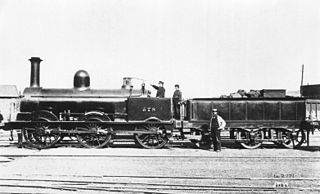
The London and North Western Railway (LNWR) DX Goods class was a class of 0-6-0 steam locomotive, designed by John Ramsbottom for freight duties. 943 were constructed making them the largest single class of locomotives built in the United Kingdom.

The London and North Western Railway (LNWR) 7 ft 6 in Single 2-2-2 class was a type of express passenger locomotive designed by John Ramsbottom. The class is better known as the Problem class for the first locomotive built, or the Lady of the Lake class for the example that was displayed at the International Exhibition of 1862.


